Once you’ve figured out what to sell, the next challenge that stops half of aspiring eCommerce business owners in their tracks is how to sell. Selecting the ideal eCommerce platform for your online store is no simple task – there’re all too many options available, it’s easy to get overwhelmed.
Some key challenges at the core of this decision are customization, pricing, and scalability. Scaling your store to accommodate growth and managing increased traffic is key for long-term success. On the other hand, finding a platform that allows the necessary customization to reflect your brand’s unique identity adds another layer of complexity.
Understanding these challenges, we’ve crafted this article to provide guidance. However, before you start picking the best eCommerce platform for your business, it’s important to understand what factors would make it the right fit for you. Also, you should know about the different types of eCommerce platforms and their advantages and disadvantages in general, which we discuss below. Then, we’ll review 8 different eCommerce solutions, examining their features, advantages, drawbacks, and pricing models, so you can find the perfect fit for your requirements.
Types of eCommerce Platforms
There’re 3 types of eCommerce platforms to consider:
- Hosted platforms (aka SaaS platforms)
- Self-hosted platforms
- Headless platforms
Hosted eCommerce Platforms Explained
Fully hosted eCommerce solutions are those that store all your files and data in the cloud.
Examples: Shopify, Wix
In this model, every aspect of your eCommerce business resides in the cloud, leaving you free from the burden of setting up and managing your own server infrastructure. The eCommerce platform securely stores and maintains all your files, data, and applications, enabling you to focus solely on managing and growing your business.
Another advantage of fully hosted solutions is that they automatically take care of credit card security and ensure compliance with PCI (Payment Card Industry) standards. So, unless you make extensive customizations to your store, you won’t need to worry about handling credit card security on your own.
Why choose hosted eCommerce
- Simplicity. Hosted eCommerce is an excellent option if your primary goal is to get your virtual store up and running quickly. With these platforms, you can swiftly set up your online shop without worrying about extensive development processes or dealing with complex technical intricacies.
Challenges of hosted commerce
- Dependency on the platform provider: Since your store’s data is stored in the cloud by the platform provider, you are reliant on their infrastructure and services. Any downtime or technical issues on their end can affect the performance of your online store.
- Potential vendor lock-in: Fully hosted solutions may make it more difficult to switch to a different platform in the future. If you move away from the provider, transferring your store’s data, design, and settings to a new platform could be complex and time-consuming.
Self-hosted eCommerce Platforms Explained
Self-hosted eCommerce means managing an eCommerce platform on your own infrastructure instead of using a hosted server. This includes handling the setup, hosting, and storage of all the data involved.
Examples: WooCommerce, BigCommerce
What sets self-hosted platforms apart is that you can modify the code to suit your business and customers (self-hosted eCommerce platforms are usually open-source software). This gives you the flexibility and independence to create your online store exactly how you want it.
Plus, with a self-hosted eCommerce platform, your data is not shared with the eCommerce platform provider, unlike with a hosted solution. That may be very important with regard to compliance with different online privacy regulations, such as GDPR and CCPA.
Why choose self-hosted eCommerce
- Total control. Choosing self-hosted eCommerce is a great option if you require complete control and flexibility over your online store’s technical aspects.
Challenges of self-hosted commerce
- Complex setup: One of the challenges of self-hosted eCommerce is that it involves a more intricate setup process than hosted platforms.
- Need for additional extensions and add-ons: Depending on your team’s technical expertise, you may need to purchase multiple extensions and add-ons to have the same basic functionalities usually included with a hosted eCommerce platform.
- Learning curve: Even with a developer on your team, self-hosted eCommerce platforms can have a steep learning curve. Depending on the complexity of your project, it may take weeks or even months of work to get the store online and then some more to tweak it.
Headless eCommerce Platforms Explained
Traditional eCommerce uses a monolithic architecture. Headless eCommerce, however, is a modern approach that separates the front-end and back-end of an online store.
Examples: Commercetools, Swell
The front end is responsible for the user interface, while the back end handles the database, inventory, and payments – and in headless eCommerce these are two separate things, not a part of one platform. The separation allows businesses to choose different technologies for each part, providing greater flexibility.
In short, headless eCommerce is like having separate teams working on the look and feel of the website (front-end) and the behind-the-scenes operations (back-end), making it easier to customize and adapt each part without affecting the other. Headless eCommerce platforms offer the backend, while the frontend is completely up to you – you can make your site look however you want.
In case with Headless eCommerce, the backend can be either hosted or self-hosted, while the front-end is usually self-hosted. Lately a lot of well known eCommerce platforms offer headless options: for example, normally hosted Shopify offers Shopify Headless Commerce, while an all-in-one self-hosted BigCommerce also provides a headless option.
Why choose headless eCommerce
- Flexibility: Opt for headless eCommerce to get more flexibility and independent management of frontend and backend, leading to higher scalability.
Challenges of headless commerce
- Complexity: Headless commerce is more complex than traditional eCommerce platforms because it requires managing multiple applications and services. To run a headless commerce platform effectively, it’s key to have a dedicated team in charge of managing it.
- Learning curve: Another challenge is the need for additional management and expertise. This includes training existing team members or hiring specialists to handle site upgrades, design templates, security, bug fixes, and troubleshooting tasks.
What are the Criteria for Choosing an eCommerce Platform for Your Online Store?
To help you find the best solution for your eCommerce business, I’ve compiled a list of 7 important factors to consider (in no particular order).
1. Ease of use
When we talk about ease of use for an eCommerce platform, it means how easy it is for you to use and understand the platform and run your online store.
This includes things like how the platform looks and how you as the store owner or manager can move around and find what you need. It also is about how simple it is to set up and manage your products, keep track of your inventory, and handle customer orders.
I understand that assessing the ease of use of an eCommerce platform can be subjective to some extent, but there are a few approaches you can take to make the evaluation more precise.
Firstly, read user reviews and feedback from individuals who have used the platform, for example, on G2 or Capterra. Look for common themes or patterns related to ease of use and overall satisfaction with the platform’s usability. Then, take advantage of platform demos or free trials if possible. Test out the platform yourself to get hands-on experience and see how easy it is to navigate, set up products, manage orders, and perform other essential tasks.
2. Customizability
eCommerce platform customizability refers to the degree to which you can personalize and tailor the solution to meet your specific business needs as well as branding requirements. A highly customizable platform allows you to add or remove features, integrate third-party tools, and make changes that enhance your customers’ shopping experience.
Look for a platform that offers extensive options for customizing the layout and theme of your online store. Evaluate whether the platform allows code-level customization, enabling you to modify its underlying codebase deeper. Due to customizability restrictions, some platforms may limit certain conversion rate optimization (CRO) tweaks to increase conversions. Remember, the level of customization often correlates with the platform’s complexity. Choose wisely for your specific needs.
3. Compliance and security
Security and compliance refer to the platform’s ability to protect customer data, secure transactions, and adhere to relevant industry regulations.
When evaluating this aspect, assess the platform’s security measures, including encryption protocols, two-factor authentication, and content security policy. Secondly, verify if the platform complies with industry standards such as PCI DSS (Payment Card Industry Data Security Standard) to ensure the secure handling of payment information. Finally, there are likely local regulations such as GDPR, CCPA, or others that your store needs to comply with depending on where you plan to operate.
4. Scalability
Scalability ensures that your eCommerce platform can seamlessly accommodate a higher number of transactions, handle increased website traffic, and support adding new features or functionalities as your business expands.
I recommend considering the platform’s ecosystem and the availability of plugins, extensions, and APIs. For example, does it have a robust marketplace where you can find scalable solutions for inventory management, order processing, or customer relationship management?
5. Online community
An often overlooked factor is eCommerce platforms’ availability of online resources to support business growth. Access to comprehensive resources helps in learning your eCommerce solution.
Look for platforms that offer active and engaged community forums where you can connect with other online sellers or developers. Check if the platform organizes online meetups or events where you can network and learn from industry experts. WooCommerce, for instance, hosts virtual meetups and Facebook groups for its community members.
6. Customer support
The level of customer support should also be a key factor when comparing different eCommerce platforms. Dealing with negative experiences in customer service can leave store owners dissatisfied, which might prompt them to explore alternative eCommerce solutions.
Evaluate the platform’s customer support availability, such as 24/7 live chat, phone support, or email response time. For instance, platforms like Shopify offer 24/7 customer support via various channels. Then, assess the availability of self-help resources like FAQs, tutorials, and documentation available.
7. Cost
Let’s not forget the cost factor when choosing an eCommerce platform. Considering a solution within your budget makes perfect sense, but if you’re serious about growing your eCommerce business, don’t just go for the cheapest option. Instead, treat it as an investment and choose a platform that aligns with your long-term growth business and growth goals, even if it means spending more upfront.
Evaluate the cost of the platform’s subscription plans, including any tiered pricing based on features and functionality. Not only that, but also consider payment processing fees and other applicable charges, which can significantly impact the overall cost.
Also, consider the cost of any necessary add-ons to enhance your store’s functionality. These could include payment gateways or shipping integrations. For instance, WooCommerce offers various extensions that need to be purchased separately.
8 Best eCommerce Platforms for Your Business
1. Shopify: Best for Small Businesses Just Starting out
Shopify is a subscription-based, fully hosted eCommerce platform that helps small businesses build an online store.

Key Shopify features
- Product and inventory management: Shopify simplifies product and inventory management by enabling unlimited product additions with multiple images. It also provides an easy-to-use back-end panel for inventory tracking, stock management, and the convenience of importing or exporting products through CSV files.
- Powerful analytics: Shopify analytics provides detailed information about your store’s performance, including sales, traffic sources, and customer behavior. With 2 main sections—product insights and sales/customers—you can gain insights into your best-selling products, customer interactions, and purchase patterns.
- Abandoned cart reminders: Shopify’s abandoned cart reminder helps businesses identify customers who have added products to their cart but haven’t completed the purchase. By sending targeted emails, businesses can remind these customers about their abandoned carts and increase revenue potential. Did you know that implementing the right checkout optimization strategies can lead to an impressive increase of almost 36% in conversion rates? This not only boosts sales but also tackles the card abandonment rate problem.
- Payment integrations: Select from a diverse selection of payment integrations, including PayPal, Stripe, Amazon Pay, Apple Pay, Klarna, and more.
- Shopify PoS: This is a convenient point-of-sale (PoS) system that seamlessly connects with your Shopify store. That way, you can easily accept payments, manage inventory, and oversee your store operations from the Shopify dashboard.
- Built-in SEO capabilities: Shopify’s online stores have built-in SEO capabilities, automatically taking care of essential tasks such as generating canonical tags, sitemap.xml, and robots.txt files. You also can customize title tags, meta descriptions, and URLs for your blog posts, webpages, products, and collections to further optimize your content for search engines.
- Robust integrations: With Shopify’s extensive library of over 8000 applications, you have many integration options at your disposal. Among other things, Shopify has integration with Mouseflow, a powerful behavior analytics solution that can be installed on your Shopify store.eCommerce managers, UX managers, CRO managers, and marketers use Mouseflow’s heatmap feature to get insights into the elements on their site that attract the most attention and go unnoticed. With this information, marketers can make informed adjustments to optimize user engagement and maximize conversions. Another Mouseflow feature is recording user sessions, which allows you to understand customers better and discover friction areas that prevent them from converting.
Shopify pros & cons
Pros:
- User-friendly interface: Shopify’s interface is user-friendly and visually pleasing, so users can easily access information about any customer’s order, handle orders, and update relevant data.
- Rich application store: Shopify’s application store offers over 1000 third-party applications, enabling merchants to add new features and capabilities as their eCommerce business expands.
Cons:
- Limited customization: Shopify has limitations on customizing your online shop, and costs can increase as you add more features and plugins.
- Potentially expensive: Some users say that Shopify’s fees are higher than for other e-commerce platforms.
Shopify pricing
Shopify offers 3 key plans, starting from $39 per month, which comes with basic reports and 24/7 support. See the full pricing breakdown here.
There’s also Shopify Plus, a more expensive tier for bigger eCommerce businesses that starts at about $2,000 per month. The main differences between plans boil down to payment processing fees.
2. WooCommerce: Best for Small Businesses with an Existing WordPress Website
WooCommerce is an open-source self-hosted eCommerce platform and a plugin built for WordPress. It allows users to easily create and customize their online stores, offering a wide range of features and functionalities to enhance the shopping experience for customers.

Key WooCommerce features
- Customization options: Customize your store page at no extra cost. You can personalize every aspect yourself or select from various attractive themes.
- Flexible payment processing: Process payments with a wide range of built-in gateways for Stripe, Paypal, Apple Pay, Amazon Pay, credit cards, bank transfers, checks, cash on delivery, and more.
- Seamless WordPress integration: WooCommerce is built on WordPress, the most popular CMS (content management system) worldwide. This integration makes it easier for website owners to manage their online store using WordPress’s user-friendly principles.
- Thousands of free and paid extensions: WooCommerce offers over 800 free and paid extensions to enhance your e-commerce store. These extensions cover functions like customer service, payments, reporting, analytics, store management, and more. Also, since WooCommerce is a plugin for WordPress, and WordPress has a Mouseflow integration, you can use Mouseflow together with WooCommerce to record user sessions and optimize your eCommerce store based on the insights that you get. Here’s how to set up Mouseflow for WooCommerce.
- Order and inventory management: WooCommerce simplifies order and inventory management with its integrated system. Easily track and handle your inventory while overseeing the entire order process.
- In-depth documentation: WooCommerce provides comprehensive documentation covering troubleshooting, how-to guides, API endpoints, store editing materials, and more.
WooCommerce pros & cons
Pros:
- Greater flexibility and customization: The biggest WooCommerce advantage is its flexibility allowing shop owners to create a unique and personalized online store tailored to their customers’ PrestaShopneeds.
- Comprehensive product management features: WooCommerce offers extensive product management features, allowing you to easily add, edit, categorize, and enhance products with descriptions, images, pricing, variations, and more advanced features like reviews and upsells.
Cons:
- Ongoing effort required: WooCommerce requires constant work to be able to create a really eye-catching store.
- Steep learning curve: Due to its extensive flexibility and many extensions, WooCommerce has a steep learning curve, requiring users to invest time in understanding its features and exploring the various customization options available.
WooCommerce pricing
WooCommerce is free to use. However, like WordPress, it needs hosting, payment management, and plugins, all of which cost money. So, WooCommerce pricing mostly boils down to several things: web hosting and setup expenses, domain name, extensions, design, and security. In simple terms, you can expect prices to start at around $100 per year, depending on the specific packages for each of the mentioned elements.
3. Commercetools: Best for B2B and B2C businesses needing flexible API architecture
Commercetools is a headless ecommerce platform that relies on the so-called MACH architecture (Microservices, API-first, Cloud-native, Headless). With its high scalability, Commercetools enables you to build tailored customer experiences that cater to your specific requirements for B2B, B2C, and D2C business models.
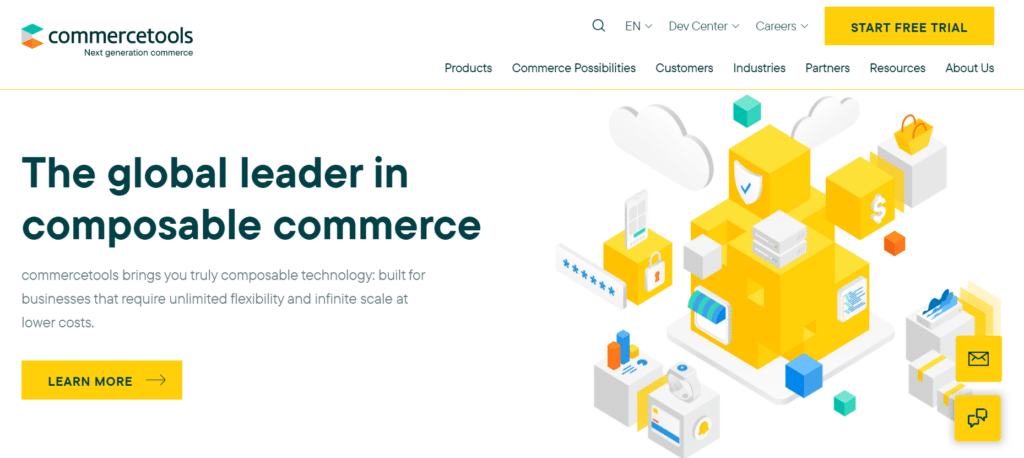
Key Commercetools features
- Product Information Management (PIM): The Commercetools merchant center allows you to centralize and manage product information across multiple channels and touchpoints.
- ML-powered category recommendations: The recommendation engine analyzes product attributes to accurately predict the most appropriate categories for each product, ensuring efficient categorization.
- Shipping and return management: Seamlessly integrate logistics and supply chain into your order process for a streamlined and efficient shipping and return management experience.
- Unified cart: Get a complete view of the checkout process. Manage pricing, shipping, currencies, and discounts across multiple stores for a consistent cart and order behavior.
Commercetools pros & cons
Pros:
- Comprehensive API capabilities: Commercetools offers a comprehensive API, simplifying integration with other services So, it’s a developer-focused eCommerce platform—not ideal for teams without developers onboard.
- High flexibility: As a cloud-based and headless eCommerce solution, Commercetools provides the freedom to easily design and implement custom solutions.
Cons:
- Fewer integrations with 3rd party tools: Commercetools has fewer integrations with third-party tools, which may limit the seamless integration of external solutions companies rely on.
Commercetools pricing
Commercetools offers an annual fee and pay-as-you-go options for third-party services. The annual fee is based on your eCommerce revenue, making the pricing fully personalized.
4. PrestaShop: Best for Customers Looking for a Free Hosted Solution
PrestaShop is a leading open-source self-hosted eCommerce solution for creating and managing multiple online stores.
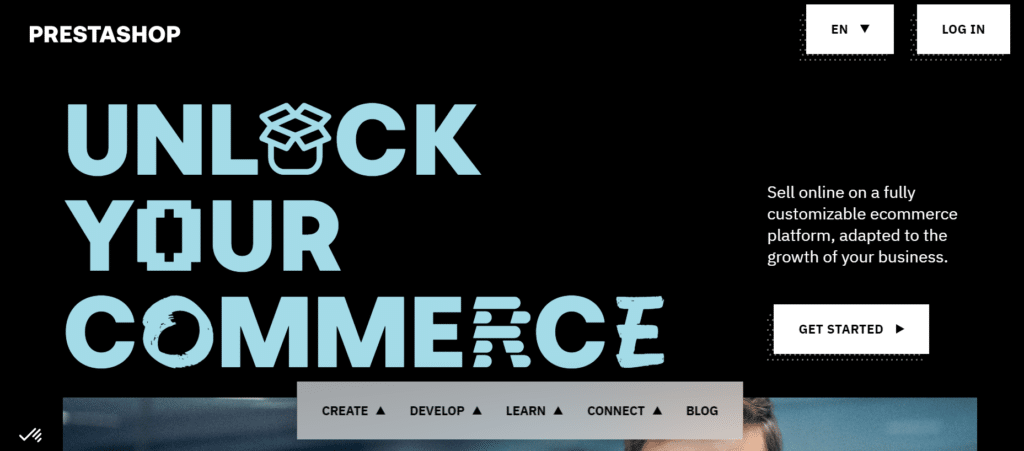
Key PrestaShop features
- Inventory management: PrestaShop’s inventory management feature allows businesses to track their products, receive out-of-stock alerts, and maintain efficient stock control.
- Multiple store management: Manage inventory, orders, and customer data across different storefronts from a single panel.
- Payment processing: Facilitate seamless transactions with various payment options, including PayPal Standard and Pro, Skrill, Stripe, Apple Pay, Revolut, Klarna, and many others.
- Omnichannel marketing: PrestaShop allows users to connect and interact with customers across multiple channels, ensuring consistent messaging and engagement throughout their shopping journey.
- Third-party integrations: PrestaShop integrations may not be as comprehensive as Shopify’s. One of the integrations that you can use is Mouseflow — add Mouseflow to your PrestaShop site to visualize and analyze customer interactions on your website. Get insights into individual user behaviors, uncover hidden patterns, and use this information to improve your eCommerce funnels.
PrestaShop pros & cons
Pros:
- Greater customization: As per this verified G2 review, PrestaShop offers a wide range of functionalities, settings, and automation options for your store’s content, as well as visually appealing designs and a user-friendly experience.
- Multilingual support: PrestaShop supports 25+ languages, ensuring accessibility and ease of use for a diverse user base.
Cons:
- Costly add-ons: Some available add-ons can be quite expensive, increasing the overall cost of setting up and maintaining an online store.
- Requirement of developer knowledge: Working with PrestaShop may require a certain level of technical expertise, so you may need to hire a professional developer at your own cost.
PrestaShop pricing
PrestaShop is free to use, but it doesn’t mean it won’t cost you anything to run an online store with it. Just like with WooCommerce, you’ll need to pay for hosting and an SSL certificate to get your store up and running. And if you don’t have coding knowledge, you might need to hire a developer to assist you in setting up the store.
5. Swell: Best for small businesses looking for an API-first eCommerce platform
Swell is a headless eCommerce platform that allows you to design unique shopping experiences.
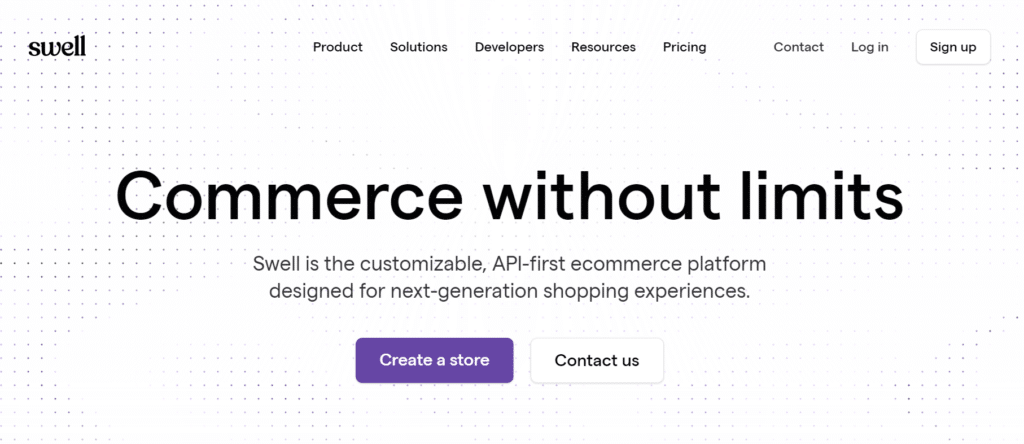
Key Swell features
- Subscription management: Simplify your eCommerce subscriptions with a centralized control panel, allowing you to sell various products and effortlessly manage upgrades, downgrades, and tailored invoices.
- Multi-warehouse management: Expand your customer reach and improve shipping efficiency by managing multiple shipping locations effortlessly, leading to quicker deliveries and reduced expenses.
- Cross-sells and up-sells: Increase sales by providing additional product suggestions (cross-sells) and upgrades (up-sells) to customers on product pages and at checkout (learn more about eCommerce product page optimization).
- Guest checkout: Simplify the checkout process by offering a guest checkout option, where customers can purchase items without creating an account.
Swell pros & cons
Pros:
- Affordable starting price: Get started with Swell for just $19 per month, which comes with 1GB of data storage and 2 admin users.
Cons:
- Sales volume limit: Upon exceeding $150k in yearly sales on the Basic plan, you may be required to switch to a pricier plan.
- Limited developer support: Access to developer support requires subscribing to the Unlimited plan, which costs $2,000 per month.
Swell pricing
Swell has 3 main plans, starting from $89/month for 5 admin users. But they also offer the Starter plan that only costs $19 per month, which is perfect for those who are new to eCommerce and only need basic features. You can view the full pricing here.
6. BigCommerce: Best for Medium and Large Businesses Seeking a Platform with Advanced Customization Options
BigCommerce is the leading fully-hosted eCommerce platform with a number of comprehensive solutions for fast-growing businesses.
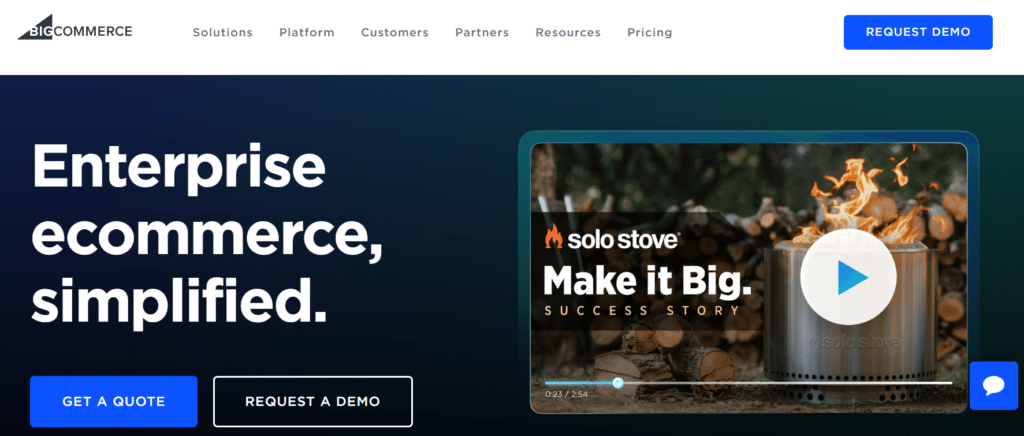
Key BigCommerce features
- One-page checkout: BigCommerce has a simple and smooth one-page checkout that reduces hassles and helps increase sales.
- Bulk pricing: Sellers can offer special discounts for buying products in larger quantities, making it great for B2B stores or products bought in bulk.
- Blogging functionality: BigCommerce includes a built-in blog feature that allows you to write and share posts about your products and store — a great way to add a personal touch to your store’s online presence and improve your SEO (Read more about eCommerce SEO and its KPIs).
- Omnichannel selling: With BigCommerce, you can sell your products on various platforms like Amazon, Walmart, Etsy, and even social media, all from one central place. This makes it easy for you to manage your sales across different channels (Here are 5 things to keep in mind if you want to expand your business to Amazon).
BigCommerce pros & cons
Pros:
- Drag-and-drop page builder: BigCommerce offers a user-friendly drag-and-drop page builder, making it simple for users to create and customize their online store without extensive coding knowledge.
- Reporting tools: BigCommerce provides robust reporting tools across all plans. It lets merchants gather insights about their store’s performance and customer behavior.
Cons:
- Plans with sales volume restrictions: BigCommerce limits annual online sales, which could hinder rapidly growing businesses. If these limits are exceeded, an upgrade to a more expensive plan is necessary.
BigCommerce pricing
Currently, 4 plans are available on BigCommerce, starting from $39/month (paid monthly) for an unlimited staff account. See the full pricing here.
7. Wix eCommerce: Best for Those Looking for Easy-to-design eCommerce Websites
Wix eCommerce is a cloud-based website builder that allows users to create eCommerce websites and mobile sites using drag-and-drop tools.
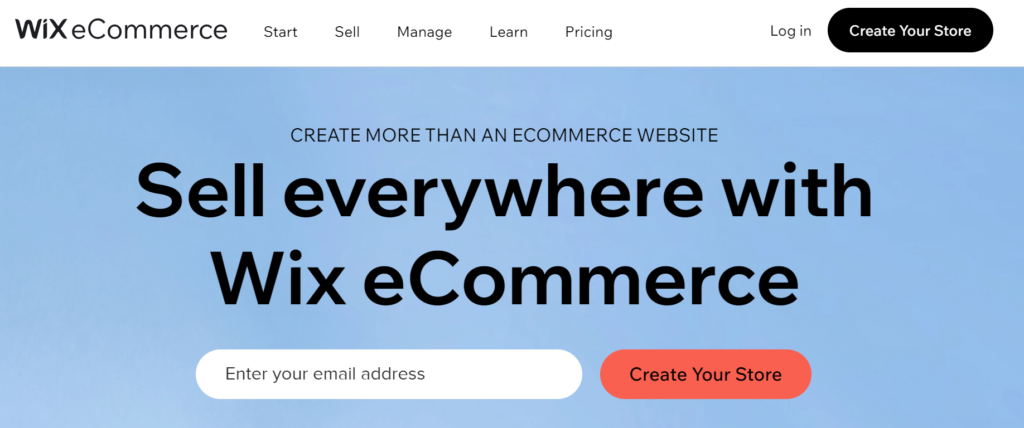
Key Wix eCommerce features
- Buy now, pay later (BNPL): Customers can pay you in small, manageable installments. You can select from well-known BNPL services like Klarna, Afterpay, LayBuy, Sezzle, etc., to provide this convenient payment choice at checkout.
- Wix POS solution: Easily sell online and in person with Wix’s handy POS solution. It helps you keep track of your inventory, sales, orders, payments, and customer profiles, no matter where you make the sale.
- 500+ templates: Choose from 500+ templates to create a unique online store that matches your business perfectly.
- Facebook and Instagram Ads: Reach the right audience with automatic ads on Facebook and Instagram. Create a campaign, and Wix will take care of targeting, testing, tracking sales, and more, making advertising hassle-free.
- Lead generation: Create customizable forms to gather contact information, accept online payments, request product or store feedback, and more.
Wix eCommerce pros & cons
Pros:
- Affordable solution: Wix offers budget-friendly and user-friendly website building without needing developers.
- Multilingual support: Wix is great for creating websites in various languages, supporting over 180 languages.
Cons:
- Storage limits: Wix plans have limited storage, requiring pricier plans as your website grows.
- Slow loading speed: As per G2 reviews, mobile loading of Wix websites can be slow due to graphic-heavy templates, affecting your eCommerce shop performance.
Wix pricing
Wix offers 4 business and eCommerce plans, starting from $20/month, which comes with 20GB of storage space and 24/7 customer support. View all the Wix plans here.
8. Square Online: Best for those just trying out eCommerce
Square Online is a hosted eCommerce platform that enables businesses to sell products, offering built-in inventory management, a point-of-sale (POS) system, and many other capabilities.

Key Square Online features
- Square POS: Use the free Square POS software to sell in-person, online, over the phone, and on the go. Connect sales and inventory to your online store without coding.
- Customized receipts: Personalize how your receipts look from the online Square Dashboard. If you have multiple locations, you can create different receipt styles for each.
- Multi-location management: Easily handle all your business locations from the Square Dashboard. Customize business profiles for each location with specific hours and individual bank accounts or tags for easy tracking.
- eGift cards: Offer digital gift cards to customers anytime. After setting up the free Square eGift Cards order site, customers can send gift cards via email, valid for in-store and online purchases.
- Low stock alerts: Allow store owners to receive daily emails highlighting items that are running low or out of stock.
Square Online pros & cons
Pros:
- Free version: You can start using Square for free with all the necessary basic features.
- Dependable payment processing: Square’s payment system is reliable and known to be resolving issues quickly.
Cons:
- Restrictive design features: Square Online’s design options may not be as impressive as expected, leaving store owners unsatisfied.
Square Online pricing
Square Online offers 3 plans: Free, Plus, and Premium. With the Free plan, you get a website builder with SEO tools and can accept multiple payment types. See the full pricing breakdown here.
Testimonials – What eCommerce Platform the Real Users Choose
We asked eCommerce business owners about the platforms that they chose, and were surprised to receive… only testimonials from Shopify users, with one exception. Here’re some of them:
- “I have several e-commerce businesses, and we use Shopify for all of them. Compared to other options, my team opted for Shopify due to its simplicity. We have several businesses running so we wanted one that’s easy to operate and manage.” – Matt Haycox, Founder and CEO of Funding Guru.
- “I focused on integration and price when selecting an eCommerce platform for my business.In terms of integration, I carefully considered Shopify and Wix, and chose Shopify due to its exceptional integration capabilities. It seamlessly connects with payment gateways, shipping providers, and marketing tools.Regarding price, Shopify offered competitive pricing plans that aligned with my budget. I appreciated their transparent pricing structure, which included transaction fees and monthly subscription costs. This allowed me to accurately forecast and manage expenses while accessing the necessary features and services.While Shopify is an excellent choice, I wish it has lower transaction fees for external payment gateways.” – Normand Chevrette, President & CEO of CME CORP
- “We considered several platforms such as Shopify, WooCommerce, and BigCommerce. Eventually, we decided on Shopify because of its seamless integration with other systems we were already using, its robust security features, and an impressive range of themes and add-ons that were well aligned with our objectives and customer-centric approach.We’ve been largely content with Shopify. Its wide range of features allowed us to create an online store that has provided an excellent shopping experience to our customers. However, every platform has its limitations. In our case, we’ve encountered certain limitations with Shopify’s built-in search feature. It lacks the sophistication we wished for, specifically in the aspect of filtering and sorting, which might sometimes affect the ease of navigation for our customers.” – Ryan Mckenzie, Co-Founder & CMO of Tru Earth
- “We considered multiple eCommerce platforms before settling on Shopify, including Wix, BigCommerce, Magento, and WooCommerce. We chose Shopify because it offers the most features and customization options from all the platforms we looked at. It was also the easiest to manage, especially for non-tech savvy like us, so it made perfect sense.We couldn’t be happier with our choice! Shopify is an incredibly powerful and reliable eCommerce platform that allows us to do precisely what we need for our business. The customer service team is always there when we have questions or issues, and their app library makes it easy to customize our store in whatever ways necessary.” – David, co-founder and CEO of Sticker it.

Improve eCommerce Success with Mouseflow
Picking the perfect eCommerce platform is a big deal, but don’t forget about the power of user behavior analytics. With tools like heatmaps and session recordings, you can uncover where customers are dropping off and make smart choices just in time.
Understanding your visitors’ habits means you can take steps to enhance their experience. That’s where Mouseflow comes in. Our behavior analytics platform has all the features you need, like session replay tool, conversion funnels, user feedback, and heatmaps.
Sign up for a free trial of Mouseflow and see how it helps you understand the reasons behind shopping cart abandonment and exits during the checkout process.


